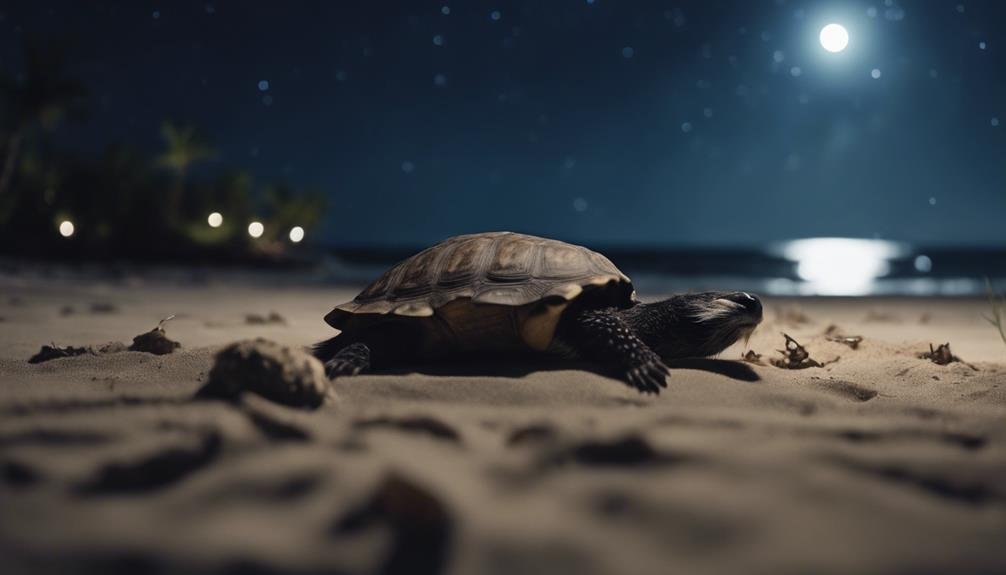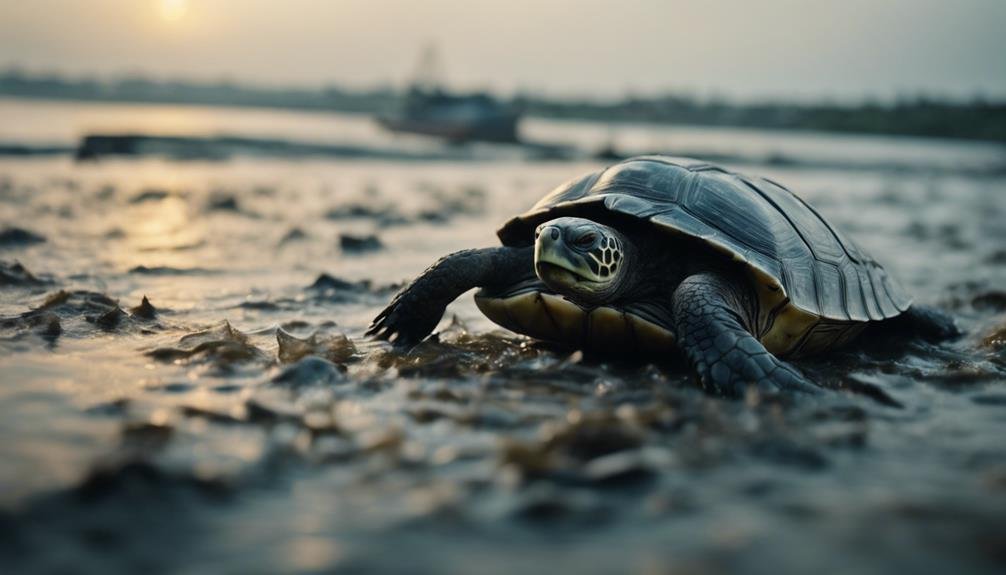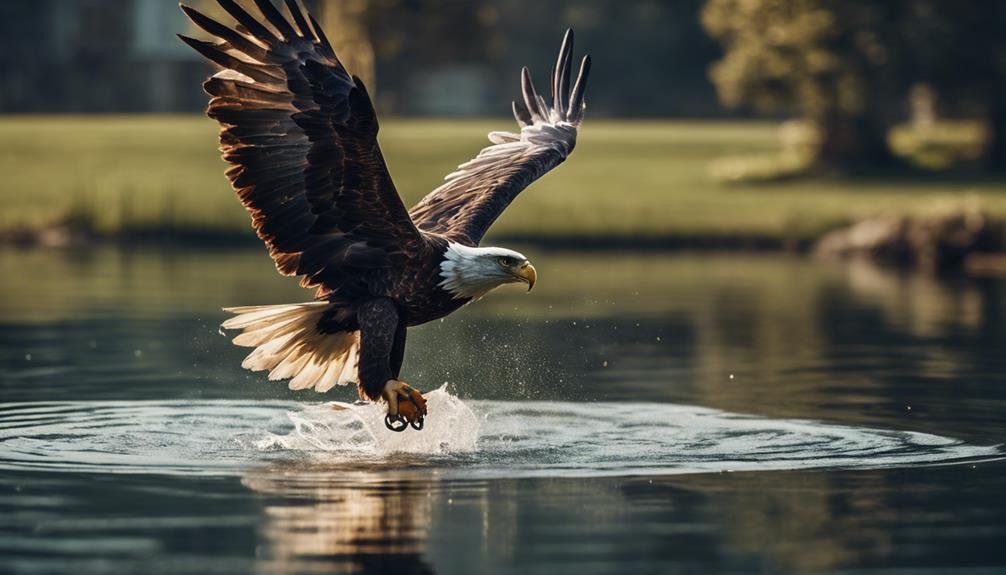You might be surprised to learn the array of predators that have a taste for turtles, from stealthy raccoons plundering nests at night to formidable sharks patrolling the oceans. These creatures play a pivotal role in regulating turtle populations, each employing unique strategies to breach the turtles’ defenses. Whether it’s the crushing jaws of an alligator or the swift dive of an eagle, turtles are under constant threat from various angles. But how do turtles survive such relentless pressure, and what ingenious adaptations have they developed to counter predators? This question opens up a fascinating exploration into the dynamics of predator-prey relationships in the animal kingdom.
Key Takeaways
- Raccoons, opossums, skunks, and foxes prey on turtle eggs and hatchlings, especially during nighttime.
- Snakes, large lizards, crocodiles, and alligators target turtles at various life stages, including eggs, hatchlings, and adults.
- Birds of prey, such as hawks, eagles, and ospreys, significantly impact turtle populations by preying on them.
- Sea turtles face underwater threats from sharks, killer whales, and predatory fish, which target them in marine habitats.
- Human activities, including illegal egg collection and habitat destruction, pose significant threats to turtle populations.
Carnivorous Mammal Threats
Several carnivorous mammals, including raccoons, opossums, and foxes, threaten turtle populations by preying on their eggs and hatchlings. You’ve probably heard about raccoons rummaging through trash, but they’re also the primary cause of sea turtle mortality in Florida. They’re not just after leftovers; they target eggs and hatchlings with devastating efficiency. Opossums, though less notorious, play a similar role. They’re known to consume young turtles and their eggs, adding another threat to already vulnerable populations.
But it’s not just raccoons and opossums you’ve got to worry about. Skunks, members of the Mustelid family, also taste turtle eggs. Their predation significantly impacts nesting success, further threatening the delicate balance of turtle populations. Foxes, part of the Canine family, opportunistically feed on turtle hatchlings and eggs, contributing to these reptiles’ predation pressures. These carnivorous mammals, each with their method of predation, collectively pose a formidable challenge to turtle conservation efforts, showing that the circle of life is complex and relentless.
Reptilian Predators
Turning your attention to reptilian threats, you’ll find that common snakes, large lizards, and crocodilians pose significant risks to turtles.
Snakes often target turtle eggs, while large lizards, such as monitor lizards and tegus, not only prey on eggs but also on hatchlings.
Meanwhile, crocodiles and alligators represent a formidable danger to adult turtles, capable of overcoming their protective shells.
Common Snakes as Predators
Snakes, including rat snakes and Formosa kukri snakes, often target turtle eggs, making them important predators in turtle nesting environments. These reptilian predators don’t stop there; they’re also known to consume adult and hatchling turtles. Their presence introduces a vital element to the natural population dynamics of turtles, influencing their survival rates.
Some snakes have even honed their hunting skills to specialize in preying on turtle eggs, which can greatly impact the reproductive success of turtle populations. As you explore the world of turtle conservation, you’ll find that snakes’ unique feeding behaviors present distinct challenges. They’re not just predators but an essential part of the ecosystem that affects how turtle populations grow and sustain themselves.
Large Lizards’ Hunting Tactics
Large lizards, such as tegus and monitor lizards, employ their keen sense of smell and powerful jaws to raid turtle nests, making them formidable predators in the struggle for turtle conservation. Known as nest-raiders and egg-eaters, these reptilian predators pose a noteworthy threat to turtle nests.
Using their acute olfactory abilities, tegus and monitor lizards locate vulnerable turtle eggs, which they consume to supplement their diets. As opportunistic feeders, tegus and monitor lizards profoundly impact turtle populations, particularly in regions where they’re considered invasive species.
Their hunting tactics contribute to the natural predation pressure turtles face, highlighting the challenges of preserving turtle nests against these large lizards’ relentless pursuit.
Crocodilian Threats to Turtles
Crocodilians, including American and saltwater crocodiles, stand out as formidable predators in the natural threats to turtles. You mightn’t often think about the dangers lurking in coastal areas, but for turtles, the presence of these reptilian giants represents a significant threat. Crocodilian threats aren’t just tales; they’re a vital reality, especially for nesting females and adults who venture too close to their domains.
Crocodilians’ predatory behavior, coupled with their powerful jaws, makes them highly effective at capturing and consuming turtles. They’ve honed efficient hunting strategies over millions of years, enabling them to prey on sea turtles in various habitats, including estuaries. In some regions, their role in controlling turtle populations through predation is undeniable and essential for the ecosystem’s balance.
Birds of Prey
As you explore the world of turtle predators, it’s essential to understand how birds of prey impact their survival.
You’ll learn about these avian predators’ unique hunting techniques, from dropping turtles to crack their shells to targeting vulnerable hatchlings.
Additionally, we’ll look at how turtles have adapted their survival strategies to contend with these aerial threats.
Hunting Techniques Explained
Birds of prey, such as hawks and eagles, deploy their sharp talons to snatch and consume turtles expertly. Hawks and eagles, with their keen eyesight, can spot turtles from a distance, swooping down with precision to grab their prey.
Ospreys, also known as sea hawks, take a different approach. They dive from great heights, plunging into water to catch turtles swimming near the surface. This spectacular hunting technique showcases their adaptability and skill.
On the other hand, bald eagles have been observed snatching baby turtles from shores or shallow waters, exploiting the vulnerable young. Meanwhile, Peregrine falcons utilize their incredible speed to execute swift aerial attacks, surprising turtles with their agility and precision.
These birds of prey have evolved distinct strategies to capture turtles, each utilizing their unique strengths.
Common Avian Predators
Moving beyond specific hunting techniques, it’s important to understand who the common avian predators of turtles are. Birds of prey, such as hawks and eagles, target turtles at various life stages and play an essential role in their natural predation.
While these majestic birds may hunt adult turtles, the hatchlings often fall victim to predatory wading birds. These hunters, foraging along coastal areas, find young turtles easy to catch.
Meanwhile, crows take a different approach by observing adult turtles during nesting, seizing the opportunity to consume fresh eggs. Each of these avian predators, with their unique hunting strategies, significantly influences turtle population dynamics across different habitats, ensuring the balance of the ecosystem is maintained.
Survival Strategies Adaptation
Turtles have evolved remarkable survival adaptations to thwart predatory birds’ hunting strategies. Birds of prey, such as hawks and eagles, often drop turtles from great heights to crack their shells. To counter this, turtles have developed hard, robust shells that can withstand impacts, offering some protection against these aerial assaults.
Hatchling sea turtles, targeted by predatory wading birds along beaches, have their survival strategies. They typically emerge at night, reducing the risk of being spotted by these natural predators. Moreover, the timing of sea turtle nesting seasons coincides with less avian predation activity, giving the young a fighting chance.
These adaptations underscore the turtles’ resilience against the challenges posed by their environment and predators.
Underwater Hunters
Sea turtles often fall prey to various underwater hunters, including large sharks and killer whales, who pose significant threats to survival. Among the most formidable are tiger sharks and great whites, known for their power and aggression. Killer whales, particularly, target the leatherback turtles in some regions, showcasing their adaptability and prowess in hunting.
You’re not just dealing with these massive predators; barracudas and other predatory fish pose a real danger, especially to the more vulnerable hatchlings and juvenile sea turtles. Even when just starting their journey in the ocean, sea birds like frigatebirds and gulls may dive to snatch them from near the surface. It’s a tough world in the ocean, with various marine predators marking sea turtles as their prey.
Here’s a quick overview of what sea turtles are up against in their underwater domain:
| Predator | Target | Danger Level |
|---|---|---|
| Large Sharks (e.g., Tiger, Great White) | All ages | High |
| Killer Whales | Mostly Leatherbacks | High |
| Predatory Fish (e.g., Barracudas) | Hatchlings, Juveniles | Medium |
| Sea Birds (e.g., Frigatebirds, Gulls) | Hatchlings | Medium |
| Other | Varied | Variable |
In their oceanic habitats, sea turtles face significant challenges, highlighting the survival threats from their aquatic adversaries.
Nighttime Nest Raiders


While sea turtles face numerous threats in the ocean, their eggs are attacked on land by various nocturnal predators. With their notorious reputation, Raccoons lead the assault on these vulnerable nests. They’re adept at sniffing where sea turtle eggs are buried in the sand, excavating them with their dexterous paws, and feasting on their rich, nutritional contents.
Skunks, though not as frequently thought of as predators of turtle nests, play a significant role in the nighttime raiding parties. They sneak into nests under the cloak of darkness, devouring eggs with little regard for the future generations they consume. Similarly, opossums, with their nocturnal habits, target these nests, capitalizing on the cover of night to carry out their raids undetected.
Foxes, too, exhibit this nocturnal behavior, opportunistically feeding on turtle eggs. Their keen senses allow them to locate nests and dig them out, leaving a trail of destruction in their wake. These nighttime nest raiders collectively pose a significant threat to sea turtle populations, with each predator’s unique method of locating and accessing the nests exacerbating the challenges conservationists face in protecting these vulnerable species.
Opportunistic Feeders
Opportunistic feeders, including raccoons, skunks, and various bird species, capitalize on turtle nests, targeting eggs and hatchlings as an easy meal. These predators are not fussy about their food sources and will take advantage of any opportunity to feed, making turtle nests prime targets. The many eggs turtles lay can’t always deter these persistent predators. Insects and invertebrates, such as ants, also join in, although their impact is generally lesser than larger animals.
Here’s a quick look at some of the opportunistic feeders preying on turtle eggs and hatchlings:
| Predator | Target | Impact |
|---|---|---|
| Raccoons | Eggs & Hatchlings | High |
| Skunks | Eggs & Hatchlings | Moderate |
| Bird Species | Eggs & Hatchlings | Variable |
| Insects | Eggs | Lower |
Predation by these opportunistic feeders plays an important role in regulating turtle populations. It’s a harsh reality of nature where only the strongest and luckiest survive. Understanding these dynamics is essential for conservation efforts, aiming to balance protecting turtles while respecting the natural ecosystem.
Human-Related Threats


Humans significantly threaten sea turtles, from illegal egg collection to habitat destruction and pollution. You mightn’t realize it, but when you enjoy those pristine beaches, there’s a hidden battle for survival beneath the waves and in the sands.
The illegal collection of sea turtle eggs for consumption and supposed medicinal benefits is decimating nesting populations. These eggs, crucial for the continuation of species, are snatched up, leaving fewer chances for the next generation of turtles to make their way into the world.
But it’s not just about the eggs. Fishing gear, like shrimp nets and gill nets, often accidentally captures sea turtles. This bycatch scenario is a grim reality for these creatures, who are entangled and unable to escape, leading to injury or death.
Additionally, human development projects, including constructing sea walls and beach nourishment efforts, chip away at the available nesting habitats. These projects might boost tourism or protect properties, leaving turtles with re to lay their eggs.
And then there’s pollution. The seas are littered with dangers, from plastic bags mistaken for jellyfish to entangling debris. These threats, coupled with deforestation’s indirect impact on nesting sites by altering water tables and beach conditions, underscore the urgency of addressing human-related threats to sea turtles.
Can Turtle Predators Affect the Number of Eggs Sea Turtles Lay?
Turtle predators can greatly affect the number of sea turtle eggs laid. Predators can decrease the overall number of eggs laid by sea turtles, impacting their egg-laying habits and ultimately endangering the population. Conservation efforts are crucial in protecting sea turtles from predators and preserving their egg-laying habits.
Conclusion
To conclude, turtles encounter a wide range of predators, from carnivorous mammals like raccoons to reptilian threats and birds of prey. Underwater sharks and killer whales hunt them, while raccoons and skunks target their nests at night. Opportunistic feeders and human-related threats add to their challenges.
Despite these dangers, turtles’ survival strategies, including their hard shells and adaptable behaviors, help them navigate a world filled with predators, showcasing their resilience in adversity.
FAQs
1. What Is the Biggest Predator for the Turtle?
You’re wondering about the biggest predator for turtles, right?
Well, it’s the sharks, especially the tiger and great white sharks. These ocean giants are known for preying on adult and juvenile turtles, making them a top threat in the water.
Killer whales also join the list, targeting leatherback turtles.
Unfortunately, human activities pose a greater risk beyond these natural predators, affecting turtle populations more severely through over-harvesting, habitat destruction, and pollution.
2. What Animal Eats a Turtle?
You’re probably wondering which animals eat turtles. Turtles face threats from various predators.
Raccoons love to snack on their eggs, especially in places like Florida. Snakes like rat snakes and Formosa kukri don’t discriminate; they go for eggs and adult turtles.
Then there are birds like hawks and eagles, who’ve figured out how to crack open a turtle shell by dropping them from heights. Lizards, including tegus and monitor lizards, also raid nests for eggs, while bobcats might dig into sea turtle nests for a meal.
3. What Is the Main Killer of Turtles?
You’re likely wondering what poses the biggest threat to turtles. Not just one culprit but several predators, such as raccoons, opossums, skunks, and foxes, greatly impact their survival.
These animals prey on turtle eggs and young hatchlings, making their journey to adulthood difficult. Understanding these threats is crucial to conservation efforts, aiming to protect these creatures from their main killers and guarantee their populations can thrive.
4. How Do Turtles Avoid Predators?
You’re likely wondering how turtles manage to keep themselves safe from danger. Well, they’ve got a few tricks up their sleeves.
Their shells serve as a sturdy shield against attacks. They’re also masters of disguise, blending into their surroundings or playing statues to go unnoticed.
Turtles have even adapted their nesting habits, hiding their eggs in the sand or opting for nighttime activities to dodge daytime predators. It’s all about staying off the radar.


